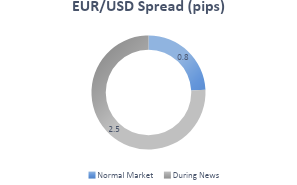Understanding Slippage and Spread in CFD Markets
All CFD traders profit margin calculator need to know about two major cost drivers: spread and slippage. These are more than just terms; they are hidden CFD trading costs that quietly chew through your profits.
So what is spread in CFD, and what does slippage in trading actually mean?
-
The spread is the difference between the bid (sell) price and the ask (buy) price.
-
Slippage is the difference between the expected execution price and the price you actually get filled at.
Although each of them only costs you a pip or two, when you trade often or at high volumes, these costs can add up quickly. For example, a trader places a buy order on EUR/USD at 1.1000, but it is filled at 1.1005. That is a negative slippage of 0.5 pips.
What Is Spread in CFD Trading?
First of all, let's look at the CFD trading spread, otherwise known as the bid-ask spread, which is how brokers, especially market makers, make money.
For instance, if EUR/USD is quoted at 1.2000 (buy) / 1.1998 (sell), the spread is 2 pips (1.2000 - 1.1998). When you enter a trade, you're already down 2 pips.
What Is Slippage in CFD Trading?
Now let's address slippage in CFD trading crypto profit calculator, which is generally when the price changes between the time the order is placed and the time it is filled.
You are more likely to experience slippage during:
-
News events
-
High volatility
-
Periods of low liquidity
Slippage can be:
-
Positive: you get a better price than you expected
How to Minimize Slippage and Spread Costs?
You won't be able to eliminate spread or slippage, but you can reduce them by using smart techniques.
Actionable Techniques:
-
Use limit orders instead of market orders as much as possible
-
Don't trade during times of high-impact news (check Forex Factory calendar)
-
Choose the best low spread brokers for CFDs 2025
-
Use a VPS or low-latency internet connection to ensure the fastest execution
-
Stay with high liquidity instruments (e.g., EUR/USD, NASDAQ100)
Example Comparison:
-
Trader A trades news with market orders → incurs $200/month in slippage/spread costs
-
Trader B trades off-peak with limit orders → incurs only $40/month on similar volume
Conclusion and Summary
Spread and slippage are not simply technical aspects of trading; they are actual costs of trading that you need to manage, or they will diminish your profit.
-
Spread is the cost between buy and sell prices – manage it by finding low spread brokers and trading when it's not highly volatile.
-
Slippage is the difference between your expected execution and what actually executed – manage this with good order types and timing.
Even a small difference of 1 to 2 pips can translate to hundreds of dollars in costs over a month. If you're serious about being profitable, it's crucial to start understanding how to calculate pip slippage, avoid bad executions, and find the best CFD brokers with low spreads.
As one trader said, “Managing execution cost was the easiest way that I increased my bottom line without having to change my trading strategy.”
Follow these recommendations and first test them out in a demo account. Get a feel for how your broker measures spread and slippage in real-time conditions, and then make what you've learned work to your advantage in your trading process.

Comments
Post a Comment